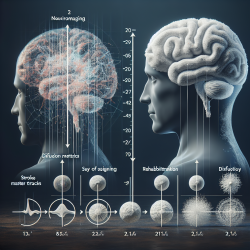Unveiling the Path to Recovery: Insights from Diffusion Metrics in Stroke Rehabilitation
In the realm of stroke rehabilitation, understanding the intricate processes that occur within the brain post-stroke is crucial for developing effective therapeutic interventions. The recent research titled Longitudinal evolution of diffusion metrics after left hemisphere ischaemic stroke offers groundbreaking insights into the physiological changes that occur in the brain's white matter following a stroke. By examining diffusion magnetic resonance imaging (dMRI) metrics, this study provides a detailed view of the structural transformations that take place over time, offering valuable information for practitioners aiming to enhance their skills and contribute to patient recovery.
Understanding the Study
The research conducted by Boucher et al. focuses on the longitudinal pattern of evolution of diffusion metrics in different parts of the ipsilesional white matter after a left hemisphere ischaemic stroke. The study involved 17 patients and assessed changes at three critical stages: acute (24–72 hours post-stroke), subacute (8–14 days post-stroke), and chronic (6 months post-stroke). The diffusion metrics analyzed included fractional anisotropy (FA), mean diffusivity (MD), axial diffusivity (AD), and radial diffusivity (RD).
Key Findings and Their Implications
The study's findings reveal significant insights into the physiological processes occurring at different stages of stroke recovery:
- Acute Stage: The study observed low FA and MD values in the white matter lesion, indicating early axonal damage and cytotoxic edema. This suggests that therapeutic interventions during this stage should focus on minimizing further damage and supporting cellular recovery.
- Subacute Stage: An increase in AD and RD values was noted, reflecting ongoing axonal damage and the beginning of myelin degradation. This stage presents an opportunity for interventions aimed at promoting axonal repair and preventing further myelin loss.
- Chronic Stage: The chronic stage exhibited elevated MD and RD values, indicating significant myelin degradation. Rehabilitation efforts during this phase should focus on strategies to enhance myelin repair and improve functional outcomes.
Practical Applications for Practitioners
For practitioners in the field of stroke rehabilitation, the insights gained from this study can be instrumental in refining therapeutic approaches. By understanding the specific changes occurring in the brain's white matter at different stages post-stroke, practitioners can tailor interventions to address the unique needs of patients. This may involve:
- Implementing early interventions to mitigate axonal damage and support cellular recovery during the acute stage.
- Focusing on promoting axonal repair and preventing further myelin loss during the subacute stage.
- Developing strategies to enhance myelin repair and improve functional outcomes in the chronic stage.
Encouraging Further Research
While this study provides valuable insights, it also highlights the need for further research to fully understand the complex processes involved in stroke recovery. Practitioners are encouraged to engage in ongoing research efforts to explore additional diffusion metrics and their implications for rehabilitation. By contributing to the growing body of knowledge, practitioners can play a pivotal role in advancing stroke recovery strategies and improving patient outcomes.
To read the original research paper, please follow this link: Longitudinal evolution of diffusion metrics after left hemisphere ischaemic stroke.










